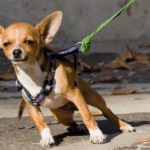Love the Leash!
You’re happily walking down the path with Mr. Woofers, enjoying the sun, the breeze, the smells…
All of a sudden Mr. W. catches wind of a wicked good scent! Off he goes, pulling the leash taut, threatening to dislocate your shoulder.
Dogs pull on the leash because it works. They’re not being stubborn, but are simply doing what has always been successful for them in the past. We humans automatically pull back, causing our dogs to pull harder. Before we know it, the companionable stroll we were anticipating has become a tug of war, leading to frustration and crankiness at both ends of the leash.
As with any undesirable behavior, we want to be sure that pulling on lead is no longer rewarding for our dogs. At the same time, we want to make it rewarding for them to stay with us and walk without pulling.
Here is a fun method of training our dogs what we DO want: to walk on a loose leash.
CLICK/TREAT AT YOUR SIDE
Begin loose leash lessons in a low-distraction environment such as your family room. Once your dog is succeeding in an easier area, raise the difficulty level incrementally, moving to your back porch, then your back yard; front porch, then your front yard; and so on.
Use a clicker, or a verbal marker such as “good”, or “click”, at the exact moment that your dog performs the desired behavior.
Get ready:
- Hold the leash in your right hand, along with your (optional) clicker. Place your leash hand at your waist, in the center of your body, in “Belt Buckle Location”.
- The leash should be loose, forming a gentle “J”.
- Put 10 or 15 treats in your left hand.
Introduce the concept:
- Begin the exercise by standing in place.
- When your dog enters the “Zone” near your left heel, click or use your verbal marker, and drop a treat next to and a little behind your left heel.
- Repeat several times until your dog begins to seek out the Zone.
Add a little movement:
- Take a step, clicking and dropping a treat every time your dog enters the Zone.
- Increase the number of steps before you click and treat ever so gradually to keep your dog within the range of success.
The click or verbal marker is telling your dog that a position in the Zone is rewarding, and your treat placement further reinforces the desirable location.
Artist Lili Chin has made her poster on Polite Leash Walking available for educational purposes. Click to download a copy of Part 1 of this excellent visual aid!
TIPS AND TROUBLESHOOTING
Begin this exercise with a high rate of reinforcement (“ROR”), clicking and treating in place once per second, then per two seconds, etc.
As you begin walking, keep the ROR high, clicking and treating for every step. Once your dog succeeds with every-step-clicking, click for every two steps. Success? Move up to three steps, and so on.
As you introduce this exercise, keep a consistent rhythm, like a musical rhythm, to your steps, clicking, and treating. As your dog becomes more fluent, ever so gradually add a little randomness.
If your dog gets ahead of you, turn so that he’s behind you, and try clicking a little before he catches up with your heel. Drop the treat or feed directly from your hand, next to or a little behind your heel.
If your dog continues to get ahead of you, raise your ROR for a bit, before gradually adding an extra step to your step-click-treat sequence, so that he will find it more rewarding to stay with you.
TAKING THE REWARD OUT OF PULLING
In order to convince our dogs that pulling is not a good strategy, we have to eliminate the reinforcements, hidden and obvious, that they receive for the behavior. If they get where they want to go when they pull, they will come to think pulling is required to get anywhere. Not only is it annoying for us when our dogs pull, but the constant stress on their skeletal structure and musculature can be quite damaging, even without considering the consequences for their delicate throat area if the leash is attached to a collar.
Here are three quick tips to help:
- Before the leash is taut, and before your dog reaches the end of it, pause and anchor your hand to your waist or hip. As he reaches the end of the leash, wait for him to turn around as if to ask why you’ve stopped. Praise him for checking in, and set off in a new direction, preferably at an angle to your previous path of travel.
- If your dog has tightened the leash, don’t pull back. Rather, imagine that your dog is at twelve on the face of a clock, and you are at six. Take a step or two toward three o’clock. This releases the tension on the leash enough to cause your dog to rebalance, but (in a perfect world) not so much that he continues charging ahead. Set off in a new direction, preferably at an angle to your previous path of travel.
- If your dog has tightened the leash, don’t pull back. Instead, draw in the leash hand over hand, without increasing or decreasing the tension that your dog has put on it, as you walk to his shoulder. Once you are all the way to his shoulder, if he hasn’t checked in with you already, use a food lure, favorite toy, or “twinkly fingers” to get his attention and direct him to join you in walking in another direction.
LOOKING AHEAD
Leash techniques are like a rich language, with many reward-based skills available to help us and our dogs enjoy the connection. We’ll be writing about other ways to work with the leash in future blogs.
Would you like us to touch on specific challenges? Email [email protected], or visit our Facebook page.




